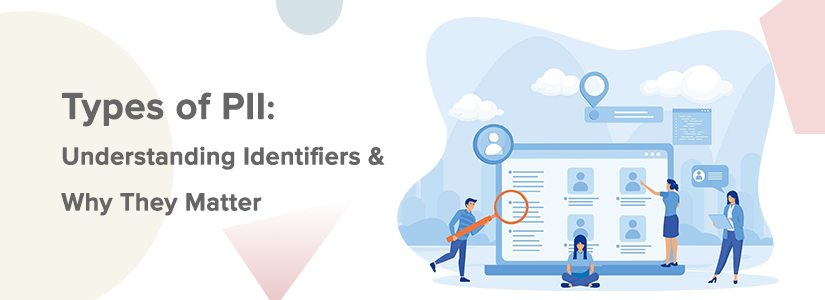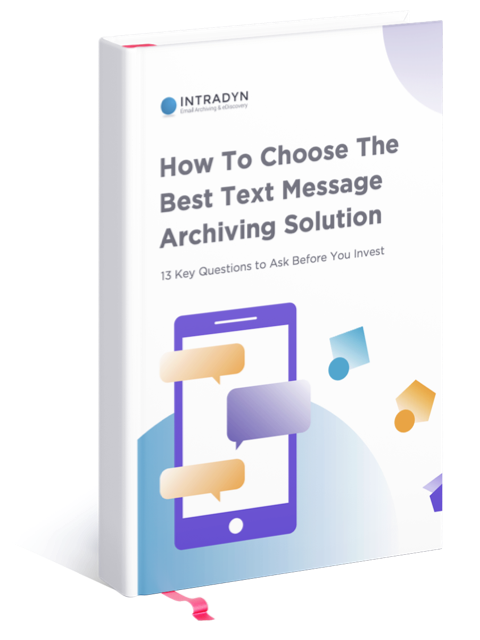Types of PII: Understanding Identifiers and Why They Matter

In a world where data is currency, protecting personal information is critical for businesses, governments, and individuals alike. But knowing what qualifies as Personally Identifiable Information (PII) is only the beginning. To safeguard it effectively and comply with global data privacy laws, it’s essential to understand the different types of PII and how they’re categorized, in order to protect sensitive data and stay ahead of evolving privacy risks.
In this blog, we’ll explain:
- The difference between direct and indirect identifiers
- What makes PII sensitive or non-sensitive
- How different industries handle PII
- Why these classifications matter for compliance and cybersecurity
What Is PII? A Quick Recap
Personally Identifiable Information, or PII for short, is any information that can be used to distinguish or trace an individual’s identity, whether that data is used alone or in combination with other information. The National Institute of Standards and Technology (NIST) includes:
“(1) any information that can be used to distinguish or trace an individual’s identity… and (2) any other information that is linked or linkable to an individual.”
To better understand how PII is handled and protected, it’s important to explore how this information is categorized. Some pieces of information can identify someone on their own, while others only become revealing when combined with additional data. Similarly, not all PII carries the same weight; some details are more sensitive and require stronger protections.
Direct vs. Indirect Identifiers
Direct Identifiers
These data points can identify a person without the need for additional information. They’re unmistakable and specific.
Examples of Direct Identifiers:
- Full legal name
- Social Security Number (SSN)
- Passport or driver’s license number
- Personal phone number
- Home address
- Biometric data (fingerprints or facial scans)
If you have access to this information, you can quickly pinpoint an individual’s identity. For this reason, direct identifiers are typically classified as sensitive and require the highest level of protection.
Indirect Identifiers
These data points don’t identify someone on their own, but they can become identifying when combined with other data. While they may seem harmless in isolation, they pose a serious risk when cross-referenced with additional datasets.
Examples of Indirect Identifiers:
- Date of birth
- Zip code
- Gender
- Job title
- IP address
- Purchase or browsing history
Context is everything
Take this for example: knowing that someone is a woman born in March 1984 and living in a specific ZIP code might not seem like much. But studies have shown that 87% of U.S. residents could be uniquely identified using just those three data points. That’s why organizations must treat even seemingly harmless information with caution.
Sensitive vs. Non-Sensitive PII
Beyond how PII identifies someone, it’s also important to consider how harmful it could be if exposed. This is the basis of risk-based classification, where data is categorized as either Sensitive or Non-Sensitive to help determine the level of protection it requires.
Sensitive PII
Sensitive PII carries a higher risk. When compromised, it may result in significant impacts such as identity theft, financial fraud, or reputational damage. As a result, it is typically governed by strict legal and regulatory requirements.
Examples include:
- Social Security numbers
- Health records (under HIPAA)
- Financial account numbers
- Login credentials
- Biometric identifiers
- Passport or driver’s license details
Due to its elevated risk, sensitive PII must be protected with robust security measures. This includes encryption, restricted access, and continuous monitoring to prevent unauthorized exposure.
Non-Sensitive PII
Non-sensitive PII still identifies a person but is generally less harmful if exposed on its own. This includes:
- Email addresses
- Phone numbers
- Usernames (without passwords)
- Device IDs
- Public employment or education details
The sensitivity of PII can change depending on how it’s used or combined. For example, a list of email addresses might seem harmless, but when linked to health or financial information, the risk increases significantly.
The key takeaway? Non-sensitive PII can quickly become sensitive when combined with other information.
Real-World Examples by Industry
Healthcare
In the healthcare sector, organizations handle an enormous volume of highly sensitive PII tied to patient care. Under regulations, including HIPAA, direct and indirect identifiers must be protected with strict safeguards. Patient names and insurance ID numbers are identifiable. However, even data such as admission and discharge dates, appointment times, or room numbers that are considered indirect can lead to privacy breaches when mishandled. Medical test results, diagnoses, and treatment plans fall under sensitive health data that, if exposed, could result in identity theft, insurance fraud, or discrimination.
What makes healthcare especially vulnerable is the interconnected nature of its systems. PII is often shared between hospitals, clinics, insurance providers, and third-party vendors. This complexity increases the attack surface and raises the stakes for compliance and protection. Even minor lapses, such as sending a patient email to the wrong address or leaving printed records unattended, can trigger significant legal consequences.
Finance
Managing PII that directly identifies clients is only part of the challenge. Financial organizations also track behavioral patterns that can reveal a person’s financial life. Sensitive financial data is especially valuable to attackers, making this sector a prime target for breaches and fraud. As a result, security and compliance standards in finance are among the strictest across industries.
Some common types of PII handled in finance include:
- Bank account numbers (sensitive)
- Credit scores (sensitive)
- Transaction history (indirect)
- Account usernames (non-sensitive alone, sensitive when paired with credentials)
Even seemingly minor data points, when combined, can be used to carry out identity theft, apply for fraudulent loans, or initiate unauthorized transactions. Institutions must remain vigilant and adopt multi-layered protection strategies to prevent data exposure.
Retail
Retailers may not manage health records or financial portfolios, but they still collect a wide array of personal data through customer interactions, purchases, and online activity. This often involves storing full names, contact details, and shipping addresses in customer accounts. When combined with loyalty programs, saved payment methods, or login credentials, even basic information can become sensitive.
Browsing behavior can also be linked to individuals, especially when combined with tracking cookies and authentication data. A breach in this sector can lead to phishing attacks or financial fraud. In an era of personalized marketing and digital storefronts, data that appears harmless at first glance must still be protected.
Why PII Classification Matters
Classifying the types of PII your organization collects isn’t just about staying organized. It lays the groundwork for compliance, strengthens your data protection efforts, and shows customers that you take their privacy seriously.
Regulatory Compliance
Various privacy laws distinguish between types of PII and impose different rules depending on sensitivity:
- GDPR – requires special protections for sensitive personal data, including consent and limited storage duration.
- CCPA – gives users the right to know what information is being collected and to opt out of its sale.
- HIPAA – mandates strict controls over health-related identifiers, even seemingly indirect ones.
Failing to classify PII correctly could lead to regulatory violations, legal penalties, and reputational damage. For example, under GDPR, organizations can be fined up to €20 million or 4% of global revenue for non-compliance.
Data Protection Strategies
Classification helps determine which types of data need the strongest protections. For example:
- Sensitive PII should be encrypted both at rest and in transit.
- Access controls should be enforced for direct identifiers.
- Monitoring and alert systems should flag unusual access to sensitive data.
Proper classification allows organizations to prioritize their cybersecurity investments, focusing efforts where the risk is highest. This not only strengthens overall security but also ensures resources are used efficiently, targeting the areas most vulnerable to breaches or misuse.
Risk Mitigation and Customer Trust
Customers are increasingly privacy-conscious. They want to know their data is safe, and they’re quick to leave brands that fail to deliver. By understanding and protecting different types of PII, businesses show that they take data privacy seriously, which in turn builds loyalty and trust.
How Intradyn Can Help You
Intradyn provides advanced email archiving and data compliance solutions tailored to today’s evolving privacy landscape. Whether you’re storing direct identifiers or handling sensitive data, Intradyn ensures your email communications and texts are encrypted, searchable, and auditable. With Intradyn, organizations can confidently manage their data while protecting privacy and maintaining trust.
Summary of Main Points
- PII is divided into direct and indirect identifiers, where direct identifiers (such as full name or SSN) can identify a person on their own, indirect identifiers (like zip code or birthdate) require context or additional data to become identifying.
- Sensitive PII includes high-risk data such as medical records, financial account numbers, and biometric data. Exposure of this type of information can lead to severe consequences, including identity theft, legal penalties, and reputational damage.
- Non-sensitive PII includes lower-risk information, for instance, email addresses or usernames, which may not pose a threat on their own but can become sensitive when combined with other data.
- Even indirect identifiers can compromise privacy, especially when aggregated. For example, combining a birthdate, zip code, and gender can uniquely identify most individuals in the U.S.
- Different industries handle different types of PII, and each faces unique regulatory and cybersecurity challenges. For example, healthcare must comply with HIPAA, while finance must adhere to strict anti-fraud protocols.
- Proper classification of PII is essential for regulatory compliance. Laws like GDPR, HIPAA, and CCPA have specific requirements and restrictions based on the sensitivity of the data being collected or processed.
- Misclassification or underestimation of PII risk can result in non-compliance, data breaches, financial penalties, and loss of customer trust.
- PII classification helps organizations implement risk-based security controls, allowing them to prioritize encryption, access control, and monitoring efforts where they matter most.
Frequently Asked Questions (FAQs)
What’s the difference between direct and indirect PII?
Direct PII (like a Social Security Number or full name) can identify someone on its own, while indirect PII (like ZIP code or job title) needs to be combined with other information to become identifying. Both can pose privacy risks, especially when aggregated.
Why does it matter if PII is “sensitive” or “non-sensitive”?
Sensitive PII (like medical or financial data) poses a higher risk if exposed and is subject to stricter legal protections. Non-sensitive PII is still identifiable but carries a lower standalone risk. However, it can become sensitive in combination with other data.
Can indirect PII still lead to identity theft?
Yes. While indirect PII isn’t inherently identifying, it can be cross-referenced with other data to reveal an individual’s identity. For example, a ZIP code, birth date, and gender can uniquely identify most people in the U.S.
What industries need to be most concerned with PII classification?
All industries should care, but sectors like healthcare, finance, and retail face particularly high stakes due to the volume and sensitivity of the data they handle. Each is also governed by its own set of compliance regulations (e.g., HIPAA, GDPR, CCPA).
How can my organization start classifying PII correctly?
Begin by identifying what personal data you collect and mapping it to direct/indirect and sensitive/non-sensitive categories. Use this classification to guide your security controls, access policies, and compliance workflows. Tools like Intradyn’s archiving solutions can help automate this process and ensure ongoing compliance.

